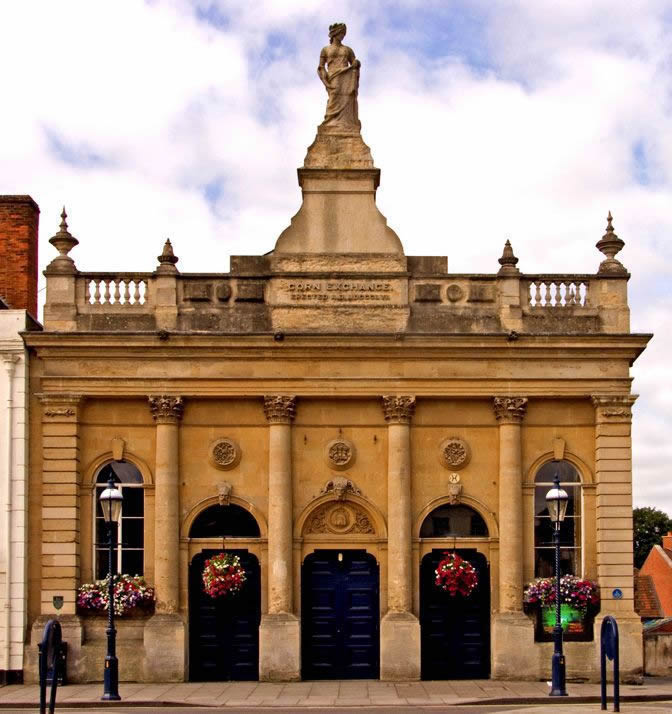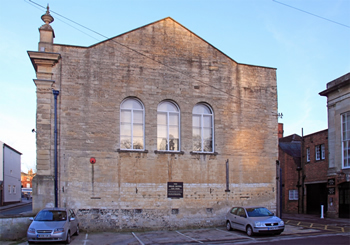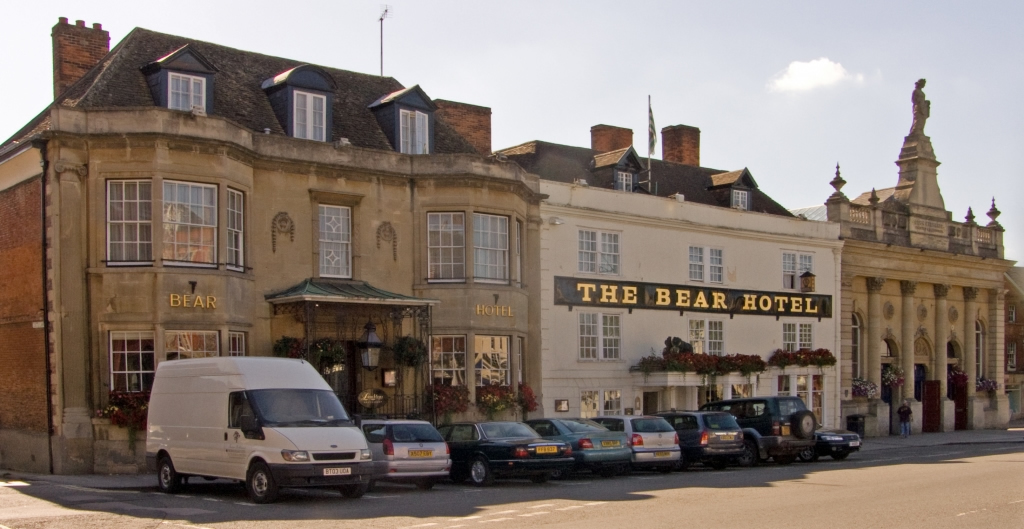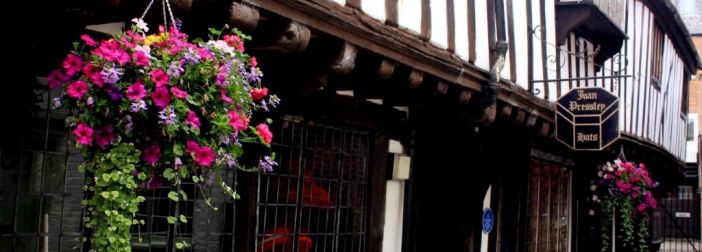The Corn Exchange, Devizes Wiltshire
Devizes had a Corn Market as far back as 15th century. Traders would sell and measure their corn around the Market Cross.
Much of the information in this article was suppied by the local History group of Devizes U3a.

This article contains a history of the Corn Exchange, the listing by English Heritage as a grade 2 building and the regulations introduced by the Town Council for its use in 1857.
As early as 1837, 178 farmers and dealers petitioned for a covered corn market to protect their produce which had for many years been stacked against 2 semi-circles of railings in the centre of the Market Place. Such a building, they thought, would increase the trade of the town at large.
On October 25th, 1855 a public meeting was held in the Town Hall to consider a covered in building for the corn merchants. It was presided over by the Mayor, J.E. Hayward. It was well attended by local inhabitants and the principal farmers and corn factors of the district. It was proposed by Mr. J. J. Fox and seconded by Mr. H. Kent Norris and resolved that, in the opinion of this meeting it is desirable that a covered in corn market should be provided, and that the present market be the site of the new building. A committee, of 15 members with the power to add to their numbers, was elected to take such measures as appears advisable to organize the procedure.
On 24th April 1856 they reported that they had only had three sites proposed to them of sufficient size one in the Bear Inn Yard, one in premises occupied by a Mrs. Erles united with the Shambles, and a third being property below Mr. Houses premises next to the Shambles. The Committee decided that the Bear Yard site was the most eligible and recommended it to the Town Council for approval. Mr. Davis, the owner of the Bear was willing to accept £1000 for the land and Great Western Railway, who were then making the line from Hungerford to Devizes and had purchased the land which is now Station Road, were agreeable to the scheme.
The Bear Assembly Rooms had shops underneath and a first floor verandah from which election results were proclaimed for many years. One of the shops was used in mid 19th C as a coach office. The Assembly Rooms were removed to the rear of the Bear and now houses the hotel's Ballroom.
Applications for subscriptions were sent throughout the district and received a reasonable response. The Committee stated that they thought that the building would not cost more than £2000. Mr. Darby-Griffith, M.P., gave £100 on condition that the new building should face and open on to the Market Place. Altogether, the 2 M.P's, S. Watson Taylor and C. Darby-Griffith gave £200 each towards the expenses. Taylor also paid for the gas fittings and Christopher Darby-Griffith paid for the clock and the statue of Ceres, the Roman Goddess of the Harvest, that crowns the building. It was tendered for by a Mr. J. Thropp of Leeds at a cost of £35 inclusive of fittings and was accepted.
Soon there was some considerable opposition to the Bear site but following another public meeting the site was approved. More applications for donations were sent out and within a month over £2000 had been raised, this encouraged the Committee to press ahead with the scheme.
In June 1856 advertisements were placed to find an architect. At a Town Council meeting held on 1st. August 1856 (where it was reported that the subscriptions amounted to £2072 with another £70 donated for a clock) careful consideration was given to all the submitted designs, about 60 in all, and it was decided to accept one from Mr. William Hill, the designer of Portsmouth Guildhall, who thought the cost would be about £1500.
Tenders for the building were invited, about 12 were received, they varied in price from £1900 to £2735. A tender of £1910 of J.Randell of Devizes was accepted. His agreement to carry out the work, dated 18th March 1857, included a clause whereby the work was to be finished by 1st. August following. However, a fair amount of extra work was later found to be necessary. Difficulties were encountered in the construction work because of the proximity of the Castle Ditch which had steep sides about 20feet deep and some wells, the cost of which amounted to £546 so the total cost of the building including the land was £3456. By June 1857 subscriptions amounted to £2652 and a mortgage was raised for the balance to be secured by tolls.
By the end of November 1857 the Corn Exchange was complete and on 3rd. December it was formally opened by Mr. H. Butcher (junior) the then Mayor. With the Corporation he went in state to the Market Place where the Town Crier proclaimed that the Market Place site was no longer the mart for Corn Dealers. A public dinner followed, a novel feature of the dinner was the presence of ladies which a local newspaper thought "not desirable". The new building greatly increased trade and prestige of the market. By 1889 traders came from as far afield as Bristol, Uxbridge and Cardiff.
 The
Corn Exchange was built in Victorian "Classical" style of Bath Stone,
more readily available after the opening of the Kennet and Avon Canal in
1810. The building, with its Corinthian Columns, stone balustrades and
relief carvings, is surmounted by a statue of Ceres, the Roman Goddess
of Harvest. It gave Devizes one of the largest public halls in
Wiltshire.By the early 1960's they were still weighing corn there but
the building had taken on a wider use, hundreds would attend Livestock
Dinners there & the town used it for celebrations, dances, carnivals,
county meetings and General Election counts. Above right the rear of the Corn Exchange
The
Corn Exchange was built in Victorian "Classical" style of Bath Stone,
more readily available after the opening of the Kennet and Avon Canal in
1810. The building, with its Corinthian Columns, stone balustrades and
relief carvings, is surmounted by a statue of Ceres, the Roman Goddess
of Harvest. It gave Devizes one of the largest public halls in
Wiltshire.By the early 1960's they were still weighing corn there but
the building had taken on a wider use, hundreds would attend Livestock
Dinners there & the town used it for celebrations, dances, carnivals,
county meetings and General Election counts. Above right the rear of the Corn Exchange
It shot to National fame when its glory days were recalled in the film "Far from the Madding Crowd" to be shown as part of 2005 Festival.By the late 1980's the building had deteriorated to a run down, draughty hall. County events were staged elsewhere, the plastic false ceiling masked a fine roof and even the huge clock was hidden. The major events of the week were furniture auctions and discos, and it was the latter which finally forced Devizes to think of a new future for the Corn Exchange. Complaints of noise put the entertainment license in jeopardy, the building had no soundproofing and something drastic needed to be done.
Below the Bear Hotel with the Corn Exchange to its right
 The refurbished building reopened on 3rd. May 1995 by Sir Charles Morrison. The refurbished building has:
The refurbished building reopened on 3rd. May 1995 by Sir Charles Morrison. The refurbished building has:
- A Basement bar with bar store (Merchants Bar) and a dance floor (Millers) with table seating, cloaks and toilets and a toilet for disabled persons. It can have a seated audience of 200.
- the Ground Floor, public foyer, with double height display and exhibition space with information boards showing what's on and forthcoming attractions, a ticket office, stairs and lifts to all levels, disabled persons toilet, access to projection room on mezzanine main function room (Ceres Hall) with stage, screen and a catering kitchen with servery, will take 210 for dancing with a seated audience of up to 450 people. The flexible plan enables use for films, theatre, exhibitions, displays and markets.
- The Plant Room with changing rooms behind linked by a staircase to the stage.
- The First Floor (Administration Office) a large function room (Yeoman Room) with servery for tea and coffee and a store for chairs (Wessex Room), with space for 40 dancers and a seated audience of 58.
- A new roof was added, fully insulated with renewed slates and double glazed roof lights and blinds.
English Heritage listing for the Corn Exchange.
Image of England Number: 432680
Location: THE CORN EXCHANGE, MARKET PLACE (south west side)
DEVIZES, WILTSHIRE
Date listed: 09 April 1954. Date of last amendment: 09 April 1954 Grade II
1042 MARKET PLACE (South West Side). The Corn Exchange ST 9961 2/130 9.4.54. II GV 2. Built in 1857,by W. Hill of Leeds. It has a large single storey hall with Bath stone front of 4 semi-engaged Corinthian columns and rusticated angle piers on projecting plinth, supporting entablature and stone balustrade on high blocking course, with stone urns at corners and central statue of Ceres on tall curved base with moulded capping and swag and cartouche ornament. 2 semi-circular headed windows and 3 eight-panel double doors in arched openings with 'mask' keystones.
Each door has carved medallion over and an imposing front. The detail is well carved and the design of good quality for its period. Good north side elevation, plinth and entablature returned, long range of similar round headed windows, the end bays and the centre flanked by pilasters, the parapet with urns repeated over each of these sections. All the listed buildings on the South-West Side, South-East Side, Market Hall, Market Cross and the Fountain form a group. Also all the listed buildings on the South-West Side form a group with Nos 1 to 16 (consecutive) Northgate Street.
Regulation for the new Corn xchange in 1857
On opening the Corn Exchange in 1857 theTown Council issued regulations governing the use of the building .
1. The Corn Market is to be held in the Exchange every Thursday unless this was Christmas Day or a day appointed for a public feast or thanksgiving, in which case the market would be held on the Wednesday before.
2. The Market to commence at 12 o'clock noon and close at 2p.m. - the times of opening and closing to be announced by the ringing of a bell.
3. The 3 doors on the north side to be closed at 12 noon during the months November to March.
4. All corn and seeds brought into the Exchange to be pitched or placed in such places as the Officer of the Corporation or Lessee or Collector of Tolls shall appoint.
5. All corn and seeds brought into the Exchange to be removed there from without delay after the time appointed for closing the market and all stands to be removed when required.
6. No persons to be allowed in the Exchange for purposes of business after 2.30p.m. when the doors will be closed except for the removal of sacks.
7. No nails, hooks or other things to be driven into walls but notices may be fixed to boards hung on the walls by the Corporation on payment of fees varying in amount from 10/6 to 31/6 according to size.
8. No smoking to be allowed in the Exchange during the hours of the market.
9. Any person using offensive language or causing a disturbance in the Exchange or breaking any of the rules to be liable to be removed there from.
10. No truck, barrow, table, stand or other convenience not belonging to the Corporation, to be brought into or used in the Exchange without permission.
11. Any person desiring to have a stand to be allowed to have one, to be approved of the Chamberlains and placed as they direct on payment of £3.3s yearly in advance but no stand to be used by anyone save the person paying the same.
12. Badges with numbers thereon to be provided for Porters employed in carrying Corn and Grain, and the Owners of Stores to be requested to cause one of such badges to be affixed and worn by each Porter on the right arm, so that the same may be always visible.
By order of the Council
Alexander Meek, Town Clerk
The Exchange may be granted for periodical Meetings, or for other Public or Private purposes on application to the Mayor.



